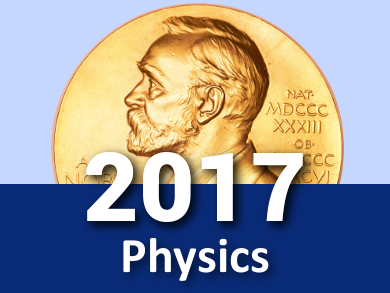The Nobel Prize in Physics 2017 has been divided, one half awarded to Rainer Weiss, LIGO/VIRGO Collaboration, Massachusetts Institute of Technology (MIT), Cambridge, MA, USA, the other half jointly to Barry C. Barish, LIGO/VIRGO Collaboration, California Institute of Technology (Caltech), Pasadena, CA, USA, and Kip S. Thorne, LIGO/VIRGO Collaboration, California Institute of Technology (Caltech), Pasadena, CA, USA, “for decisive contributions to the LIGO detector and the observation of gravitational waves”.
LIGO (Laser Interferometer Gravitational-Wave Observatory) is a collaborative project with over 1,000 researchers from more than 20 countries. The universe’s gravitational waves, predicted by Albert Einstein a hundred years ago, were observed for the very first time in 2015. The waves, coming from a collision between two black holes, took 1.3 billion years to arrive at the LIGO detector in the USA.
Rainer Weiss, born 1932, Berlin, Germany, received his Ph.D. in 1962 from Massachusetts Institute of Technology (MIT), Cambridge, MA, USA. From 1960 to 1962, he taught at Tufts University, USA, from 1962 to 1964, he was was a postdoctoral scholar at Princeton University, and in 1964, joined MIT. He is currently Professor of Physics Emeritus at Massachusetts Institute of Technology, MIT, Cambridge, MA, USA.
Rainer Weiss invented the laser interferometric technique which is the basic operation of LIGO.
Barry C. Barish, born 1936, Omaha, NE, USA, received his Ph.D. in physics in 1957 and his Ph.D. in experimental high energy physics in 1962 from University of California, Berkeley, CA, USA. In 1963, he joined California Institute of Technology (Caltech), Pasadena, CA, USA. He is curretnly Linde Professor of Physics Emeritus, Caltech.
Kip S. Thorne, 1940, Logan, UT, USA, received his Ph.D. in 1965 from Princeton University, NJ, USA. He is currently Feynman Professor of Theoretical Physics Emeritus, California Institute of Technology, Pasadena, CA, USA. In June 2009, he started writing and movie making. His first film project was Interstellar, where he worked together with Christopher Nolan.
Selected Papers
A. Einstein, Näherungsweise Integration der Feldgleichungen der Gravitation, Sitzungber Preuss. Akad. Wiss. Berlin 1916, part 1, 688.
A. Einstein, Über Gravitationswellen, Sitzungber. Preuss. Akad. Wiss. Berlin 1918, part 1, 154.
B. C. Barish, K. S. Thorne, R. Weiss, et al., The basic physics of the binary black hole merger GW150914, Anal. Phys. 2016, https://doi.org/10.1002/andp.201600209
Kip S. Thorne, Black Holes: The Membrane Viewpoint, in Highlights of Modern Astrophysics: Concepts and Controversies (Eds. Stuart L. Shapiro, Saul A. Teukolsky), John Wiley & Sons, New York, 1986, pp. 103–161.
C. B. Barish, Video: The Long Odyssey from Einstein to Gravitational Waves,The Royal Swedish Academy of Sciences, 13 January 2017.
K. S. Thorne, Video: Disturbed Kerr Black Holes, The Royal Swedish Academy of Sciences 25 May 2016.
J. Aasi et al. (LIGO Scientific Collaboration), Advanced LIGO, Class. Quantum Grav. 2015, 32, 074001. https://doi.org/10.1088/0264-9381/32/7/074001
B. P. Abbott et al. (LIGO Scientific Collaboration and VIRGO Collaboration), Observation of gravitational waves from a binary black hole merger, Phys. Rev. Lett. 2016, 116, 061102. https://doi.org/10.1103/PhysRevLett.116.061102
B.P. Abbott et al. (LIGO Scientific Collaboration and VIRGO Collaboration), GW151226: Observation of gravitational waves from a 22-solar-mass binary black hole coalescence, Phys. Rev. Lett. 2016, 116, 241103. https://doi.org/10.1103/PhysRevLett.116.241103
B. P. Abbott et al. (LIGO Scientific Collaboration and VIRGO Collaboration), GW170104: Observation of 50-solar mass binary black hole coalescence at redshift 0.2, Phys. Rev. Lett. 2017, 118, 221101. https://doi.org/10.1103/PhysRevLett.118.221101
Also of Interest
- Who’s Next? Nobel Prize in Chemistry 2017,
Make your predictions for the 2017 Nobel Prize in Chemistry
- Nobel Prize in Physiology or Medicine 2017,
The prize was awarded to J. C. Hall, M. Rosbash, and M. W. Young, all USA, for their discoveries related to the biological clock - The Nobel Prize,
Veronika Belusa,
ChemViews Mag. 2015.
Collection of information on the Nobel Prize




